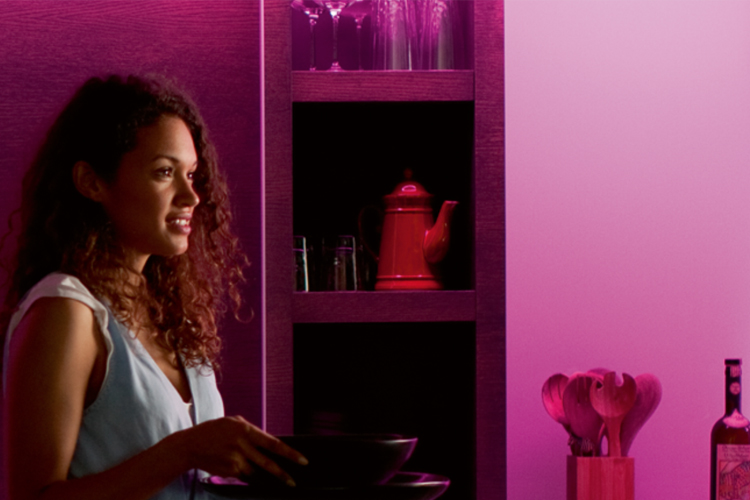Home automation continues evolving relentlessly. Almost every month, new control and management of household electrical devices systems are proposed on the market. Regarding lighting systems, Philips has introduced new interesting wireless LED lamps, the so called Philips Hue bulbs.

Aesthetically, the Philips HUE look like normal LED bulbs. Their light output is equivalent to 50 W incandescent bulbs but, thanks to the LED technology, they are much less expensive from an energy point of view. They can reduce electricity consumption up to 80%. Internal LED bulbs can emit different light colors and color temperatures. Thanks to the screw connection, compatible with the standard E27, they can be easily inserted into most of the home lamp holders.
A part from the classic components of a LED light bulb, the HUE present a small internal device for communicating with the network, enabling the reception of bytes transmitted through the Wi-Fi.
The wireless bulbs are sold by Philips in sets of three. Inside the Starter Pack, along with the three light bulbs, that can also work as normal LED bulbs, there is a bridge, powered through an Ethernet cable.
Easy installation
The installation of the Starter Pack is extremely simple. It only consists in connecting the bridge to an electricity plug and a modem-router for data transmission, via the network cable. After plugging one or more Philips HUE light bulbs in any socket of the house, you need to install the Philips app on your smartphone, to connect with the bridge and the LED bulbs. If you don’t own a device on which you can install the app – the app is compatible with any device running Android or iOS – you can send commands to the bridge by purchasing a wireless remote control. If you connect directly with the bridge, you do not need to own a router.
How does the connection with the app work?
As for the majority of electronic devices managed with an app, first, you must make sure that the software communicates with the hardware. You can do it by launching a recognition and synchronization process between the two systems. This operation can be quickly completed through a special button you will find on the application you previously installed on your smartphone.
At this point, with the app, you can send commands to the LED light bulbs through the smartphone-router-Philips HUE-LED bulbs transmission network, which uses three communication channels, that is to say, the Wi-Fi router (IEEE 802.11 ), the Ethernet and another type of Wi-Fi, responding to the ZigBee (IEEE 802.15.4) for the transmission of low-power and low-consumption wireless data (https://en.wikipedia.org/wiki/ZigBee).
The app identifies the Philips Hue bulbs individually, via recognition codes. It can manage up to 50 units, by simply swiping your finger on the touch screen of your smartphone. Colors and light intensities are then carefully set for every single bulb, but you can also simultaneously control all of the Philips HUE via a preset configuration available on the app.
The software also allows you to set the intensity of every Philips HUE light bulb, to adapt it to different times of the day and different rooms of the house, depending on where they are located. You can control the light bulbs when you are outside just simply connecting to the Internet, following the creation of its own account on the site of Philips HUE.
The bridge firmware updates autonomously, as soon as the system detects the availability of a new version on the Philips HUE server, which then provides an automatic update to all the connected lighting devices.
The advantages of the remote control
Being able to remotely control your home light bulbs is useful, for example, when you want to program them to switch on at a certain time of the day, even for simply giving the impression that someone is at home.
Basically, the ability to control the bulbs through a software, would enable them to be connected with any other electronic device operated with a computer system. To do this, it is necessary to have specific technical skills to extend the app functionality. You should be able to connect these new devices with the API (Application Programming Interface) of the app. Thanks to the Philips HUE technology, the software developer could, for example, create a game of lights, that follow the rhythm of a song.
Other features
Regarding the negative aspects of this technology, we can say that for the time being, the Philips HUE kit, has a fairly high cost. It costs more than 200 €. Even the purchase of a single Philips HUE light bulb, to extend an existing lighting system, is relatively high (50-60 €).
It is a pretty user friendly technology, however, you still must be familiar in using apps and smart devices. Moreover, to entirely benefit from the full potential of this technology, that is to say to be able to control it remotely through the internet via a computer located outside of your house, you must have an internet connection that entails extra cost, corresponding to the ADSL fee.
The ZigBee technology has a maximum communication range of about 70m, depending on possible obstacles that might be present in the environment. If you need to place a Philips HUE bulb at a longer distance from the base, then the one supported by the ZigBee technology, the bulbs won’t get any signal. This will force you to purchase Wi-Fi repeaters, which would represent an additional cost, also in terms of energy consumption.
Finally, the Philips HUE bridge is always turned on, and for this reason contributes, albeit to a limited extent, to the overall power consumption of the house. It would be preferable to have a bridge equipped with a specific mode of low power operation.
